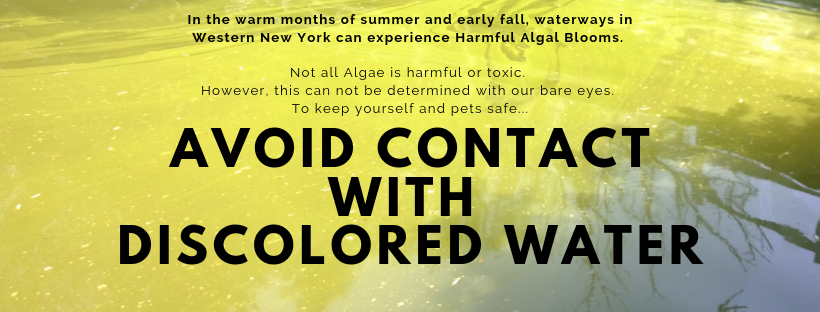
An image of a Harmful Algal Bloom (HAB) in the water.
Contact Information
Robert Coady
716.852.7483, ext. 19
rcoady@bnwaterkeeper.org
What is a harmful algal bloom?
Harmful Algal Bloom (HAB) or Harmful Algal Blooms (HABs) occur when naturally present cyanobacteria, also known as blue-green algae, multiply rapidly, often forming visible patches on surfaces of affected waterbodies. These cyanobacteria often exist at low concentrations in most aquatic systems, but several types of blue-green algae can produce toxins and other harmful compounds that can affect human, animal, and environmental health through contact, ingestion, or inhalation. HABs are likely to occur in slow-moving water with excess nutrients, and during periods of prolonged warm temperatures and sunlight.
How do I identify a HAB?
Since it is hard to identify a HAB from non-harmful algal blooms, it’s important to avoid recreating and drinking the water if signs of a bloom are present. Signs that could indicate the presence of a HAB include floating mats of algae or scums, and discoloration in waterways. Colors can include shades of green, blue-green, yellow, brown, or red (NYS DEC). Click here for some visual clues to help you identify a bloom.
How can I report a HAB?
Please report the bloom to New York State Department of Conservation. Fill out and submit a Suspicious Algal Bloom Report Form and email HABsInfo@dec.ny.gov with pictures if possible.
You can also fill out the Google form below for Buffalo Niagara Waterkeeper, which will allow you to upload images so we can visit the site and get a sample, if possible.
What health risks are associated with HABs?
Symptoms that coincide with contact of HAB include stomach, skin, eye, and throat irritation, allergic reactions, or breathing difficulties. Pets, including dogs, who come in contact with HABs through swimming or drinking affected water can experience similar symptoms. If you think you’re experiencing health risks associated with HAB, consider visiting a healthcare professional.
How can I stay up to date on local HABs?
Affected areas are listed on the New York State Department of Conservation website. You can also subscribe to the HAB newsletter.
How can I make a difference?
All around the United States, runaway algae growth caused by water pollution is threatening ecosystems, as well as people’s health and livelihood. Harmful blooms are a worldwide issue and are expected to worsen with warming waters caused by climate change. In the United States, many Waterkeeper Organizations and Affiliates are working to stop the release of pollutants that cause these blooms.
Please keep an eye out for HABs while recreating in area waterways during the hot, dry months of the year. Note that toxins potentially produced by a HAB might still be present even after it is no longer visible.





